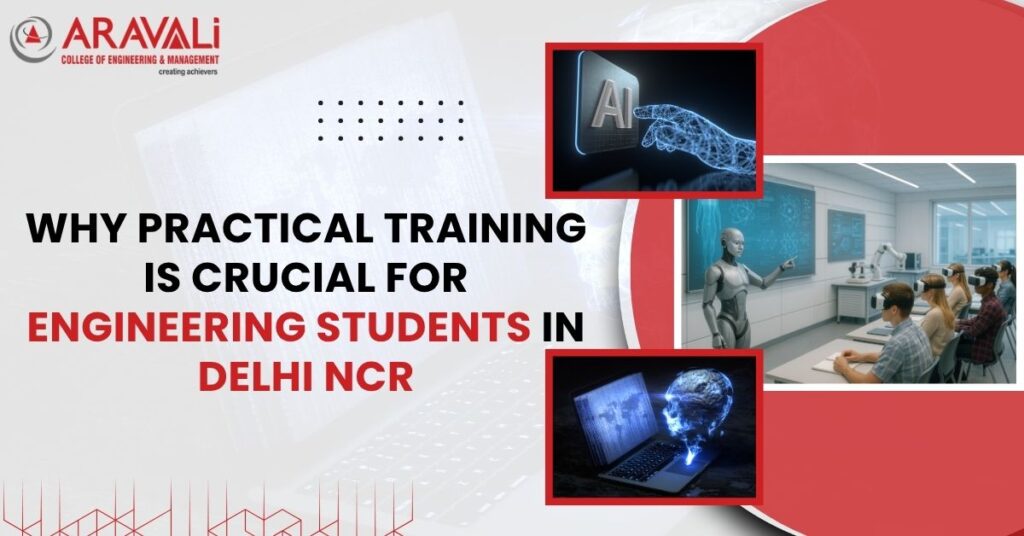
Engineering has always been considered the staple of innovation, industry, and technology. But in the modern job market, which is quite dynamic, it is no longer sufficient to acquire theoretical knowledge. Delhi NCR as well as employers in India, are seeking graduates who are able to implement classroom-based ideas into practical problems. This is where practice training becomes essential. In the case of engineering students, bridges between university studies and professional preparation are open through internship programs, on-the-job projects, laboratory work, and exposure to the industry.
The Disjuncture of Theory and Industry Expectations.
The curricula of most universities in the field of engineering mostly concentrate on theory, exams, and textbooks. Although such a background is significant, in fact, students are not usually exposed to real-life problem-solving scenarios, which makes them unprepared to work in the industry. As an illustration, mechanical engineering students can learn and understand fluid mechanics and thermodynamics in theory, but not how to implement them in terms of creating a practical product. Likewise, students of computer science can be taught programming languages, but not be able to apply this to scaled applications or business solutions. Delhi NCR employers demand that students have job-ready skills (e.g., coding, prototyping, data analysis, project management, etc.) that are not always effectively taught in conventional classrooms. Practical training will be the most important distinguishing factor that prepares students to be industry-ready.
Practical Learning is more powerful.
Practical training has one of the greatest benefits, whereby students can grasp concepts in a more practical sense. Laboratory work, training in industries, and live projects enable the students to visualize and apply what they have learnt in theory. This type of learning enhances the strength of knowledge retention, the development of critical thinking, and the ability of students to perceive the applicability of academic studies to the real world. As an illustration, students of electrical engineering who are undertaking practical tasks on circuit design in labs do not just learn the theory better but also acquire troubleshooting skills on how to go about it when things go wrong. These kinds of problem-solving skills cannot emerge just in classroom teaching.
Avoiding the Employability Gap.
One of the largest issues in the Indian job market has been employability, particularly in technical education. Reportedly, a high proportion of engineering graduates find it very difficult to get employment as they do not have practical skills. Delhi NCR employers point to the fact that they need students who can be productive immediately and not require months of further training. This issue is directly addressed through practical training programs, which include internships, industry-academia partnerships, technical workshops, and skill development initiatives. The students can obtain workplace experience, communication with professionals, and learn how an organization works through them. This practical experience will assist students in their employability and increase their likelihood of attaining greater employment opportunities.

Learning about New Technology.
Engineering is ever-changing and is undergoing advancement in artificial intelligence, data science, cloud computing, robotics, and automation. Students who solely use textbooks run the risk of being left behind since the academic syllabus requires time to revise. Practical training, nevertheless, introduces them to the new tools, software, and practices of the industry. As an example, students of computer science studying machine learning projects have a practical introduction to Python libraries, datasets, and algorithms. Students of mechanical engineering who visit CAD/CAM workshops are introduced to contemporary design programs in industries.
Developing Self-confidence and Problem-Solving.
Lack of confidence when working on real projects is among the greatest obstacles to fresh graduates coming out into the labor market. Practical training helps in developing self-confidence as students assume responsibility in performing tasks, err, and learn in a monitored situation. Be it debugging a line of code, making sense of data trends, or working with mechanical components, practical experience creates strength and self-assurance. Confidence is essential in times when students have to go through interviews, evaluations, and initial projects in a company setting.
Connections and Networking.
On-the-job training also aids in building industry contacts for the engineering students. Internships, industrial visits, and working on projects also expose students to professionals who will probably become mentors, references, and even prospective employers. These are helpful networks in terms of career opportunities, industry needs, and best practices. Internships have enabled many students in Delhi NCR to get pre-placement offers merely because they showed their potential and desire to learn under practical training programs. This confirms that exposure in the industry assists not only in the development of skills but also in career development.
Developing Soft Skills by Practical Exposure.
Although technical expertise is a necessary requirement, the need to be able to work together, communicate, lead, and be adaptable is equally important to employers today. These skills are naturally developed in practical training environments. The use of group projects, providing solutions, or cooperation with professionals in the industry helps students develop their interpersonal skills. These types of experiences make them ready to work in a wide and competitive working environment.
Getting Ready to Go Global.
The engineering job market has ceased to be restricted to the local industries. There are numerous multinational corporations that hire students in Delhi NCR to work on international projects and in international positions. The students must be able to show technical and practical skills to be able to compete on these levels. The hands-on training assists them in adapting to the international work standards, provides them with information on the global technologies, and increases their confidence in their ability to apply to global job positions. It could be coding a project with an international customer, developing AI-specific solutions, or research and development, but in any case, hands-on experience makes sure that students are competitive globally.

Conclusion
To sum up, Engineering education in Delhi NCR has become incomplete without practical training. It also provides the disjunction between theory and practice, improves employability, instills confidence, and introduces students to emerging technologies. Students can be ready to work in the contemporary environment through the appropriateness of internships, live projects, workshops, and technical training in the industry. It is thus necessary that the engineering students adopt the spirit of practical learning to win their future in a competitive job market. Institutions and businesses that advocate hands-on education are making a crucial contribution to the future of human resources. Aravali College of Engineering and Management is one of those institutions where students receive a balanced amount of theoretical and fieldwork, which means that by graduation, they are prepared to face the future.